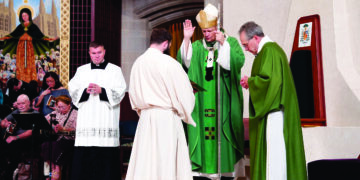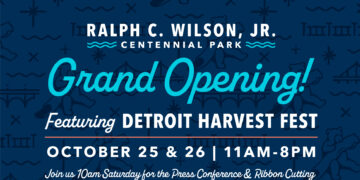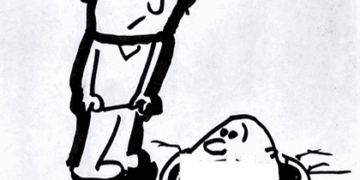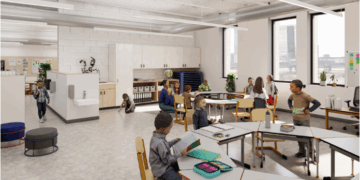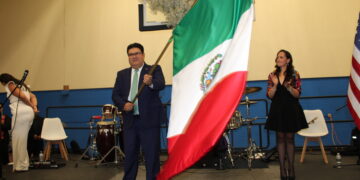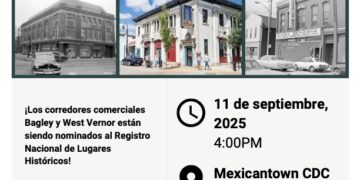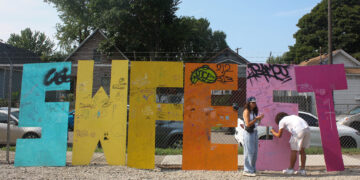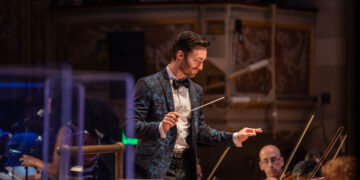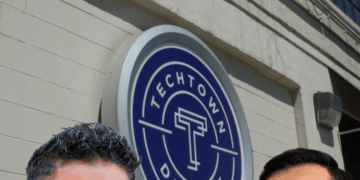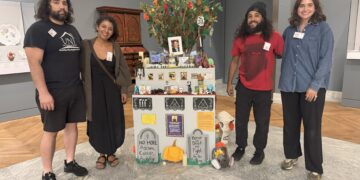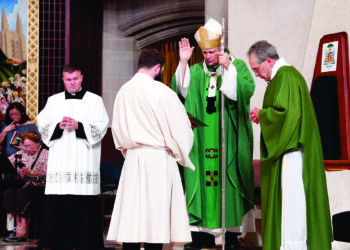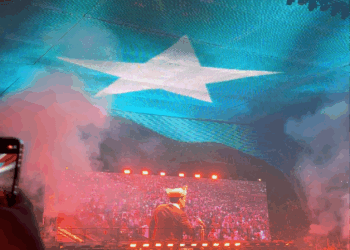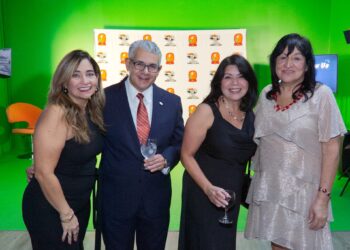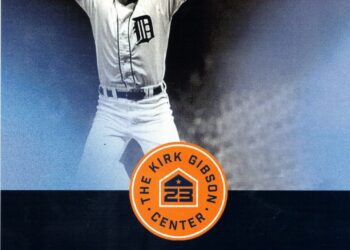Five fantastical, life-size animals made from car parts were unveiled last Friday, November 1 in the heart of Mexicantown in Southwest Detroit. The five sculptures, created by local artist Elton Monroy Duran, are inspired by Mexican folk art Alebrijes and symbolize the contributions of the Latino community to the Motor City. Alebrijes are part of Mexican folk art and Aztec folklore.

“These Alebrijes statues are an important cultural representation of heritage here through significant folk art,” said Jay Biernat, Project Manager, DPW Complete Streets. “These particular statues are the exquisite creation of Elton Monroy Duran and could not be made possible without his vision and hard work.”
Durán, is a Detroit-based visual artist. His work portrays the Hispanic community in Southwest Detroit through a series of murals. He was selected to create a series of sculptures for the Bagley Street Mexicantown streetscape.
“Alebrijes to me are a reflection of us, contemporary Mexicans. Alebrijes are usually figures made from different animal parts decorated with cheerful and colorful patterns. Contemporary Mexicans, we come from an ancient culture that was once fragmented but that we pieced back together, incorporating elements from other cultures giving shape to our own, unique cheerful identity,” said Durán. “This Alebrijes are made from different car parts tying up our relationship with Detroit and our long-time contributions as a Latino community to the Motor City.”
This unique project was made possible by the support of Knight Foundation who supplied $67,000 for material costs for the artist. The Gilbert Family Foundation supplied $37,000 for the statues’ foundations. The Gilbert Family Foundations is committed to providing Detroit residents with access to safe, inclusive public spaces.
“We are proud to partner with the City of Detroit on this project,” said JJ Velez, Director of Public Spaces for Gilbert Family Foundation. “These statues are a reflection of the vibrant, creative and passionate community of Southwest Detroit and a perfect example of how art can infuse culture into our public spaces.”
Southwest Detroit Business Association will maintain these wonderful works of art along the streetscape.
“Seeing the Alebrijes come to life in Mexicantown es una celebración of the vibrant cultural spirit that makes Southwest Detroit unique,” said Laura Chavez, President & CEO, Southwest Detroit Business Association. These sculptures are more than just art; they are symbols of the rich diversity, resilience, and creativity of our community. Bringing this project to fruition is a reflection of our collective pride and passion for preserving and promoting our heritage for generations to come,” Chavez added.
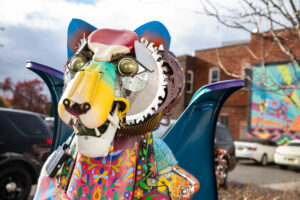
There are a total of five art sculptures: Big Cat, Giraffe, Donkey, Dog and Wolf. The giraffe towers over seven feet and the big cat, six feet.
“As an immigrant and former Southwest Detroit resident, seeing this project come to life fills me with pride. These sculptures represent more than art; they celebrate the rich heritage, hard work, and contributions of the Latinx community to Detroit,” said José Maldonado, Director, Mexicantown Main Street, Southwest Detroit Business Association. “This collective accomplishment in Mexicantown Mainstreet honors our past and inspires our future, creating a space where culture and community thrive side by side. This unveiling is for everyone who calls Detroit home and carries our stories forward.”
The redesign of Bagley from 24th Street to the I-75 Service Drive has created a versatile “shared street.” This curb-less street now accommodates both traffic and business needs while also serving as a lively plaza for special events. The project features enhanced lighting, brick pavers, landscaping, and decorative elements, making it a more welcoming space for residents, visitors, and businesses.
The Bagley Street project introduced several key changes: new roadway pavement, updated underground infrastructure, festoon and traditional lighting, street furniture, brick pavers, and enhanced landscaping. These upgrades were designed to create a more attractive and welcoming corridor where neighborhood businesses can prosper. The improvements support all modes of transportation—walking, biking, transit, and driving, making the area safer and more accessible for everyone.
The project was a $2.78M City Bond Fund Project with construction from May of 2019 with completion November 2019.
El Suroeste de Detroit se adorna con esculturas culturales.
Los alebrijes, arte popular mexicano y folclore azteca, cobran vida en Bagley Streetscape.
El pasado viernes 1 de noviembre se presentaron cinco fantásticos animales de tamaño real, hechos con partes de automóviles en el corazón del Barrio Mexicano, en el suroeste de Detroit. Las cinco esculturas, creadas por el artista local Elton Monroy Durán, están inspiradas en los alebrijes, que son parte del arte popular mexicano y del folclore azteca, y simbolizan las contribuciones de la comunidad latina a la Ciudad del Motor.

“Estas estatuas de alebrijes son una importante representación cultural del patrimonio, a través del arte popular”, comentó Jay Biernat, gerente de proyectos de DPW Complete Streets y continuó: “Estas estatuas en particular son la exquisita creación de Elton Monroy Durán y no habrían sido posibles sin su visión y arduo trabajo”.
Durán es un artista visual que vive en Detroit y fue seleccionado para crear una serie de esculturas para el paisaje urbano de Bagley Street del Suroeste de Detroit.
Su obra retrata a la comunidad hispana del suroeste de Detroit a través de una serie de murales “Para mí, los alebrijes son un reflejo de nosotros, los mexicanos contemporáneos. Los alebrijes suelen ser figuras hechas con diferentes partes de animales, decoradas con patrones alegres y coloridos. Los mexicanos contemporáneos venimos de una cultura antigua, que estuvo fragmentada, pero que volvimos a unir, incorporando elementos de otras culturas, para darle forma a nuestra propia y única identidad alegre”, dijo Durán. “Estos alebrijes están hechos con piezas de carros, uniendo nuestra relación con Detroit y nuestras contribuciones de muchos años, como comunidad latina a la Ciudad del Motor”.
Este proyecto único fue posible gracias al apoyo de Knight Foundation, que aportó 67,000 dólares para los costes de material del artista. La Gilbert Family Foundation, aportó 37,000 dólares para los cimientos de las estatuas, comprometiéndose a proporcionarles a los residentes de Detroit acceso a espacio público seguro e inclusivo.
“Estamos orgullosos de asociarnos con la ciudad de Detroit en este proyecto”, compartió JJ Velez, director de espacios públicos de la Gilbert Family Foundation y agregó: “Estas estatuas son un reflejo de la comunidad vibrante, creativa y apasionada del suroeste de Detroit y un ejemplo perfecto de cómo el arte puede infundir cultura en nuestros espacios públicos”.
La Southwest Detroit Business Association, mantendrá estas maravillosas obras de arte en el paisaje urbano.
“Ver a los alebrijes cobrar vida en Mexicantown, es una celebración del vibrante espíritu cultural que hace que el suroeste de Detroit sea único”, compartió Laura Chávez, presidenta y directora ejecutiva de la Southwest Detroit Business Association. Estas esculturas son más que solo arte; son símbolos de la rica diversidad, resiliencia y creatividad de nuestra comunidad. “Hacer realidad este proyecto es un reflejo de nuestro orgullo y pasión colectivos por preservar y promover nuestro patrimonio para las generaciones futuras”, agregó Chávez.

Hay un total de cinco esculturas de arte: un gran felino, una jirafa, un burro, un perro y un lobo. La jirafa mide más de 2 metros y el gran felino, 1 metro 80.
“Como inmigrante y ex residente del suroeste de Detroit, ver que este proyecto cobra vida me llena de orgullo. Estas esculturas representan más que arte; celebran la rica herencia, el trabajo duro y las contribuciones de la comunidad latina a Detroit”, dijo José Maldonado, director de Mexicantown Main Street, Southwest Detroit Business Association. “Este logro colectivo en Mexicantown Mainstreet honra nuestro pasado e inspira nuestro futuro, creando un espacio donde la cultura y la comunidad prosperan juntas. Esta inauguración es para todos aquellos que consideran a Detroit su hogar y llevan nuestra historia hacia adelante”.
El rediseño de Bagley desde la calle 24 hasta la I-75 Service Drive ha creado una “calle compartida” versátil. Esta calle sin aceras ahora se adapta tanto al tráfico como a las necesidades comerciales y, al mismo tiempo, sirve como una animada plaza para eventos especiales. El proyecto cuenta con una iluminación mejorada, adoquines de ladrillo, paisajismo y elementos decorativos, lo que la convierte en un espacio más acogedor para los residentes, los visitantes y las empresas.
El proyecto de Bagley Street introdujo varios cambios clave: pavimentado de la calzada, infraestructura subterránea actualizada, iluminación tradicional y luces de cadena, mobiliario urbano, adoquines de ladrillo y paisajismo. Estas mejoras se diseñaron para crear un corredor más atractivo y acogedor donde las empresas del vecindario prosperen y sean accesibles a todos los medios de transporte (a pie, en bicicleta, autobús y carro), lo que hace que el área sea más segura para todos.
Fue un proyecto del Fondo de Bonos de la Ciudad de $2,78 millones, cuya construcción comenzó en mayo y se completó en noviembre de 2019.
Traducción Carmen Elena Luna

